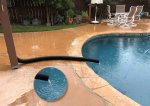- Nov 12, 2017
- 12,640
- Pool Size
- 12300
- Surface
- Plaster
- Chlorine
- Salt Water Generator
- SWG Type
- Pentair Intellichlor IC-40
A clear pool:
-you can see the heads of the screws on the main drain and see if they are standard or phillips.
-you can tell if a coin is heads or tails while in the deep end.
-it looks like gin
-"At night, I turn on the pool light, and if the water is still, I can't see the water at all. It looks like an empty pool."
The shimmer/sparkle.........that will be when the sun is bright and the water is moving. It will look like there are diamonds on your pool surface. You will need sunglasses to look at your pool.
Have you added the salt yet? If not wait until it is warm enough for your Grands to be able to get in the water. We call salt adding day "diamond day" as the salt looks like diamonds as you add it and the kids love to swim under water to look at it and they can help mix it in!
CYA test---------oh how I hate this test---------here is how I came to terms with it. GLANCE!!!!! Do not stare or you will see the dot.
Here is how I do it:
-Make sure it is a sunny day
-make up the mixture and let it sit while you do the rest of the tests
-stand with your back to the sun
-hold the tube at your tummy
-pour the mixture to the first line (100) GLANCE in then look away. If you still see the dot go to the next line.
-Keep pouring from line to line until you cannot see the dot at a GLANCE then call it good.
You can do and redo the test with the same water. Just pour it back and forth as many times as you want/need to.
Kim
Yep, I'm pretty sure it's crystal clear. And thanks for the tips. But I have no drains, and I can't throw a coin in, as no one is going to fish it out at 45°! I will go drink some gin out there later and see how it compares to the pool! That seems like the most reliable test, especially after a few!!
But you did give me a good idea. I'll compare what my pool brush looks like at 1' down, then 6' down... Seems like that would reveal any cloudiness...
No salt yet. Good tip. The g-kids will like that. They all swim with goggles, so that'll be fun for them. I've read here about the right salt to use. I'll likely use one of the water softener options you all list, as it's much cheaper than "pool salt."
I'll save your CYA test tips for spring, when I'll be adding more (for the salt water). But curious... Do you think I can replicate your method indoors? I test my water inside, in my laundry room. It has no windows and a bright LED under-cabinet light, plus a bright fluorescent overhead light, that makes for a very consistent color-comparing environment, light-wise. So I get very reproducible results as the light in there is 100% constant, day or night, cloudy or bright. And the counter in there is about "tummy level." That's where I did my first (and only) CYA test. But one gallon of CYA into 12300 gallons of pool would have been around CYA 30. Plus, I'm pretty sure I didn't wait long at all to do the test. I saw the dot when the vial was full, and then kinda gave up, thinking 30 wasn't going to register well enough, or that it hadn't been in the pool long enough (I tested only a few days after I added CYA). I've just been relying on the 1-to-12300 gallon ratio to get CYA 30. And Marty determined for me that my chlorine is evaporating at about the expected rate for this time of year, which kinda corroborated my CYA was OK. But when I go salt, I'm hoping to add just enough CYA to bring my pool to the minimum recommended CYA level. (That's when I'll retest.) That way, I'm thinking, I can keep my chlorine level at the low end of the range (for swimmer comfort) and so run my SWG as little as possible (save on electricity and SWG wear and tear) and protect my plaster as much as possible. Any logic to that thinking, or am I worrying too much about CYA? I'm coming off ruined plaster, remember, and one "expert" that has been involved in the repair explained that 6 years of pucks (and the likely resulting CYA level) were instrumental in the early degradation of my pool plaster. So I'm thinking "no pucks" and "minimum CYA" for my pool.
During the winter, I'm getting very little splash out (none, really, because nobody's been in the pool, and it's not raining at all) so the CYA level should still be at 30. And so I figured I could set CYA in the spring pretty close to whatever level I choose, just with Pool Math. I know there's a gallon in there now, and I know 12,300 is very accurate because I measured my first pool fill with a water meter. So my next CYA adjustment is going to be pretty close to accurate, closer than that CYA test would reveal, for sure. But it's the splash out from the kids I don't have any way to calculate, which means eventually I'll have to be testing for CYA...


